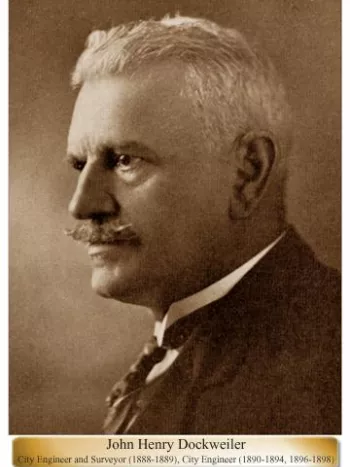
John Henry Dockweiler barely missed being a native son because his mother was visiting Lancaster, Erie County, New York when he was born on February 20, 1864. When he was six months old, his mother returned to her home in Los Angeles with her tiny son.
His father, Henry Dockweiler, was an early Los Angeles pioneer who was in business and served three times as a member of the City Council.
John Henry attended preparatory school in Los Angeles and then went to St. Vincent's College in the same city. During his adolescence, he worked eighteen months in a local hotel, and in 1881, began civil engineering studies in the Office of the City Engineer.
After a few months of study, he joined a railroad surveying party, working on location and construction projects from 1882 to 1883. He then returned to St. Vincent's for two more years of technical studies.
Since 1886, Mr. Dockweiler has been engaged in the practice of civil and general engineering. After working as a field deputy out of the office of the City Engineer in 1886, he opened offices of his own as a general surveyor and engineer. One of his first jobs was as an engineer in charge of construction of the Los Angeles Cable Railway in 1888.
During 1888 to 1889, he served as City Surveyor and Engineer. In December of 1890, he was elected City Engineer, which he held until December of 1894. He served once more as City Engineer when he was elected in 1896 though 1898.
While in that office, he originated the system of indexing records in the City Engineer's Office by divisions. He is credited with procuring in fee simple the Pacific Ocean front where the Outfall sewer empties, and in 1893 built the first Outfall sewer. In all of his official tenure, he devoted much time to the problems of City water supply and the litigation connected therewith.
The years between 1899 and 1904 Mr. Dockeweiler, engaged in consultation, installation and investigation of mining properties over the United States and Mexico.
In 1904, he went to San Francisco and for twelve years was a consulting engineer to the city attorney there in the litigation pending between San Francisco and the Spring Valley Water Company. After 1916, he served in the same capacity to the city attorney of Oakland handling litigation between the municipality and various water works companies.
Mr. Dockweiler returned to Los Angeles in 1919, where his practice included many private and semi public interests of great diversity. He served as major and consulting engineer in the National Guard of California from 1896 to 1918.
He passed away on December 21, 1941, after a lengthy illness.
Events in which he had a direct or indirect interest in while City Engineer included a city consolidation of all streetcar systems and the start of construction of a cable plant and powerhouse. A new City Charter adopted the first oil well that was drilled (successfully) in the City. Development of a deep-water port at San Pedro was underway and voters approved a new city sewage system.
Property to become Griffith Park was donated to the City and the electric system replaced horse-drawn streetcars.